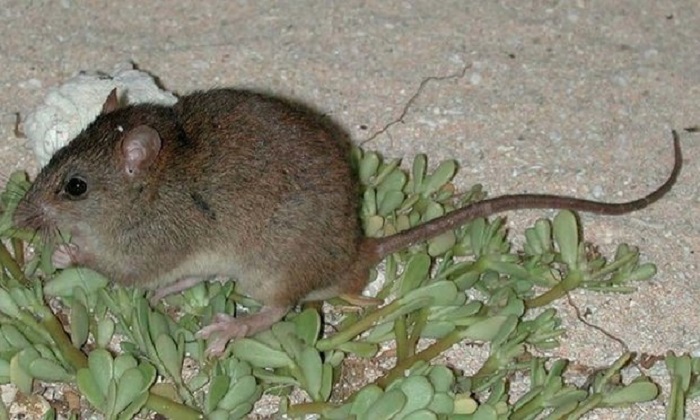An expert says this extinction is likely just the tip of the iceberg, with climate change exerting increasing pressures on species everywhere.
The rodent, also called the mosaic-tailed rat, was only known to live on Bramble Cay a small coral cay, just 340m long and 150m wide off the north coast of Queensland, Australia, which sits at most 3m above sea level.
It had the most isolated and restricted range of any Australian mammal, and was considered the only mammal species endemic to the Great Barrier Reef.
When its existence was first recorded by Europeans in 1845, it was seen in high density on the island, with sailors reporting they shot the “large rats” with bows and arrows. In 1978, it was estimated there were several hundred on the small island.
But the melomys were last seen in 2009, and after an extensive search for the animal in 2014, a report has recommended its status be changed from “endangered” to “extinct”.
Led by Ian Gynther from Queensland’s Department of Environment and Heritage Protection, and in partnership with the University of Queensland, the survey laid 150 traps on the island for six nights, and involved extensive measurements of the island and its vegetation.
In their report, co-authored by Natalie Waller and Luke Leung from the University of Queensland, the researchers concluded the “root cause” of the extinction was sea-level rise. As a result of rising seas, the island was inundated on multiple occasions, they said, killing the animals and also destroying their habitat.
It was estimated the area of the cay above high tide has decreased from 4ha in 1998 to 2.5ha in 2014. And worse for the melomys, they lost 97% of their habitat in just 10 years, with vegetation cover declining from 2.2ha in 2004 to just 0.065ha in 2014.
“For low-lying islands like Bramble Cay, the destructive effects of extreme water levels resulting from severe meteorological events are compounded by the impacts from anthropogenic climate change-driven sea-level rise,” the authors said in their report.
Globally, averaged sea level has risen by almost 20cm between 1901 and 2010, a rate unparalleled in any period during the last 6,000 years. But around the Torres Strait, sea level appears to have risen at almost twice the global average rate between 1993 and 2014.
“Significantly, this probably represents the first recorded mammalian extinction due to anthropogenic climate change,” the researchers said in their report, quietly published on the Queensland government’s website last week.
As a result, the Queensland government website now recommends suggested recovery actions not be taken. “Because the Bramble Cay melomys is now confirmed to have been lost from Bramble Cay, no recovery actions for this population can be implemented,” it says.
Although small, the island is significant for many people and animals. It is the most important breeding ground for green turtles and a number of seabirds in the Torres Strait, the researchers said, and has long been visited by its traditional custodians, the Darnley Islanders, who caught fish, turtles and birds.
The authors said the IUCN lists one other mammal that was driven to extinction, partly by extreme weather – the Little Swan Island hutia – but introduced cats on the island were considered the main driver of extinction.
In contrast, the researchers say the melomys was driven to extinction due “solely (or primarily) to anthropogenic climate change”.
The one hope for the species, the authors say, is that there might be an undiscovered population in Papua New Guinea. They say the melomys might have arrived on Brambles Cay on rafting debris from the Fly River region of Papua New Guinea. If that is true, then either the Brambles Cay melomys, or a close relative, may still live undiscovered there.
There is absolutely no doubt we will lose species due to the increasing pressures being exerted by climate change.
John White, Deakin University
The authors recommend targeted surveys in Papua New Guinea be carried out, to see if they are there.
John White, an ecologist from Deakin University in Australia, who was not involved in the study, said this extinction is the tip of the iceberg. “I am of absolutely no doubt we will lose species due to the increasing pressures being exerted by climate change,” he said. “Species restricted to small, low lying islands, or those with very tight environmental requirements are likely to be the first to go.”
A report in 2015 found one sixth of the world’s species face extinction due to climate change, and scientists have warned that the world is on the edge of the sixth mass extinction.
“Certainly, extinction and climatic change has gone hand in hand throughout the history of the world,” he said. “So, if this is one of the first, it is more than likely not going to be the last.”
More about:
















































